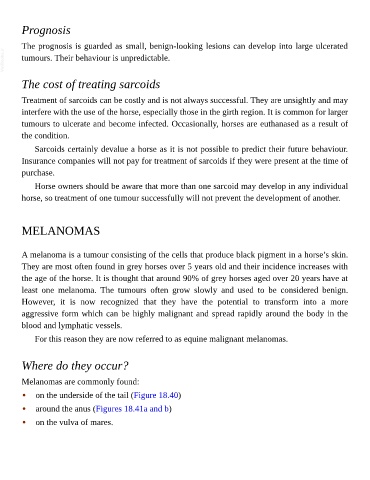Page 894 - The Veterinary Care of the Horse
P. 894
Prognosis
The prognosis is guarded as small, benign-looking lesions can develop into large ulcerated
VetBooks.ir tumours. Their behaviour is unpredictable.
The cost of treating sarcoids
Treatment of sarcoids can be costly and is not always successful. They are unsightly and may
interfere with the use of the horse, especially those in the girth region. It is common for larger
tumours to ulcerate and become infected. Occasionally, horses are euthanased as a result of
the condition.
Sarcoids certainly devalue a horse as it is not possible to predict their future behaviour.
Insurance companies will not pay for treatment of sarcoids if they were present at the time of
purchase.
Horse owners should be aware that more than one sarcoid may develop in any individual
horse, so treatment of one tumour successfully will not prevent the development of another.
MELANOMAS
A melanoma is a tumour consisting of the cells that produce black pigment in a horse’s skin.
They are most often found in grey horses over 5 years old and their incidence increases with
the age of the horse. It is thought that around 90% of grey horses aged over 20 years have at
least one melanoma. The tumours often grow slowly and used to be considered benign.
However, it is now recognized that they have the potential to transform into a more
aggressive form which can be highly malignant and spread rapidly around the body in the
blood and lymphatic vessels.
For this reason they are now referred to as equine malignant melanomas.
Where do they occur?
Melanomas are commonly found:
• on the underside of the tail (Figure 18.40)
• around the anus (Figures 18.41a and b)
• on the vulva of mares.

